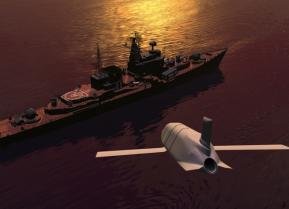LRASM: The U.S. Marines Have a New Missile to Sink China's Navy
The LRASM would outclass the Harpoon anti-ship missile’s range, be hard to detect — and could be put in the hands of US Marines to sink Chinese ships.
Earlier last month, the Navy and Air Force inked a contract with Lockheed Martin for the company’s Long Range Anti-Ship Missile, also known as LRASM.
The agreement, worth $414 million, is for the fourth and fifth lot of missiles and is the biggest LRASM contract in the history of the Lockheed missile program, reportedly totaling 137 missiles, training and logistics support, as well as additional LRASM support equipment.
In the Lockheed Martin press release, David Helsel, the LRASM director at Lockheed Martin Missiles and Fire Control explained that the Navy/Air Force award “reflects LRASM’s increasing significance to our customers’ missions. Focused teamwork around a shared vision with our customers and our dedicated supply partners remains key to this program’s success.”
LRASM, Explained:
The LRASM is a stealthy, ship-killing missile-based partially off of the earlier JASSM-ER missile and uses a “multi-modal sensor suite, weapon data link, and enhanced digital anti-jam Global Positioning System” to discriminate specific targets among groups of ships. It can receive targeting updates via a data link in real-time, or use its onboard sensors to find targets. Lockheed explains that the advanced missile is specifically designed to seek and destroy specific ships — sometimes on its own — in highly contested electronic warfare environments that could see GPS signals degraded, and where surveillance and reconnaissance would be difficult to conduct or unreliable.
The LRASM is the latest in a rash of newer, more lethal anti-ship weapons by several branches, but particularly by the U.S. Navy and Marine Corps, prompted in part by what is perceived as aggressive Chinese force posture in the Pacific region, as well as the PLA Navy’s increasing number of ships and so-called carrier-killer weaponry.
Why the U.S. Marines Need LRASM: China
The Marine Corps and Navy are not only investing in increasingly sophisticated weaponry but also reevaluating how they conduct warfare. The USMC’s top Marine, Gen. David Berger has nudged and pushed the Corps back towards their amphibious roots as of late and even thinks that groups of highly-trained Marines could help the Navy hunt down and sink Chinese submarines.
The Corps is also undergoing doctrinal upheaval at the moment, in what is the biggest force posture and restructure of the past 25 years. Pivoting from the grinding land warfare campaigns of the Middle East, Marines are preparing for a fight in the Pacific, somewhat reminiscent of their World War II-era island-hopping campaign.
This time around, however, Marines would not simply assault and capture enemy-held islands, but turn them into tiny bastions of American firepower, holding enemy surface ships and submarines at bay and denying the use of the islands by the enemy.
The LRASM could first compliment, then replace the Harpoon anti-ship missile, long the United States’ standard ship killer. And the LRASM’s long stand-off range — thought to be around 350 miles — would push Chinese ship much farther out to sea than the Harpoon’s 150-mile range would be able to: enemies beware.
Caleb Larson is a Defense Writer with The National Interest. He holds a Master of Public Policy and covers U.S. and Russian security, European defense issues, and German politics and culture.


